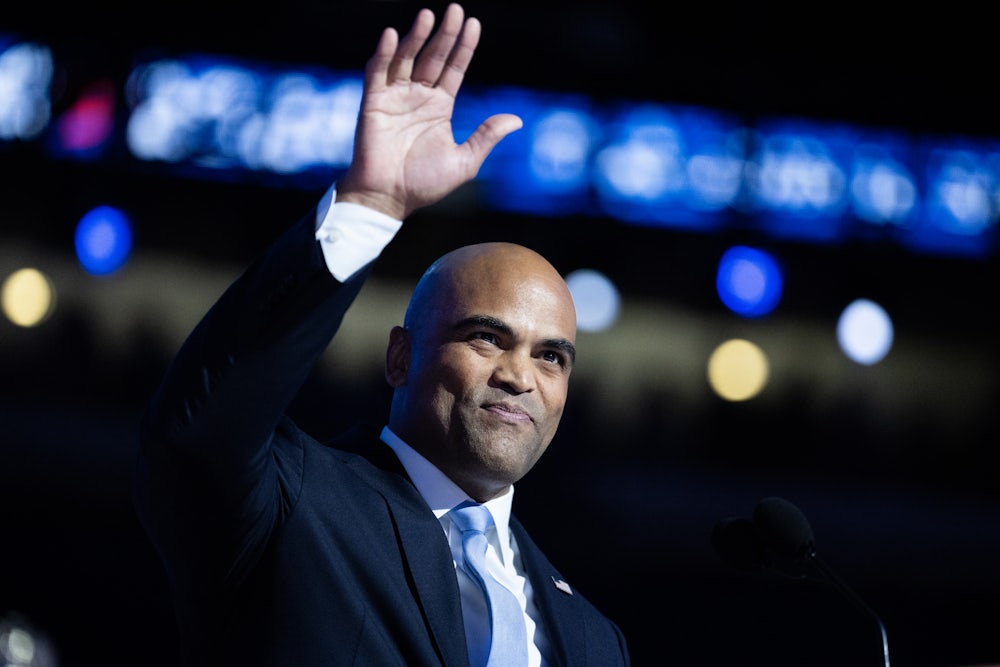When imagining the platonic ideal of a Democrat running for national office in a red state, the party’s old guard expects certain boxes to be ticked. The first among them is always the same: They have to be “tough,” a trait often signified by military service. Think Amy McGrath, the Kentuckian Marine and self-described “fiscal conservative” who challenged Mitch McConnell for his Senate seat in 2020; or MJ Hegar, an Air Force veteran who took on Texas Senator John Cornyn the same year. Next, you must cut an ad that receives tremendous national attention—then watch the money faucet flow. McGrath, for instance, outraised McConnell by more than $32 million; Hegar, in addition to outraising Cornyn, cut “viral” ads and had previously received vocal support from Hamilton creator Lin-Manuel Miranda.
The latest high-profile iteration of this brand of politician was Colin Allred, a Dallas native, civil rights lawyer, and former NFL linebacker who took on Senator Ted Cruz. His statewide strategy was code-named “Texas Offense,” and his ads were spliced with mentions of his glory days on the gridiron. He grabbed attention, and nearly outraised Cruz, a prodigiously unpopular candidate, in what was one of the most expensive races in the country. And like McGrath and Hegar before him, Allred lost by a humiliating margin.
While Cruz underperformed Trump in counties across the state, Allred also underperformed in almost all of the state’s most populous counties—most of which already swing Democratic—and barely won more than Beto O’Rourke’s 2018 total. The loss was so bad that Texas’s longtime Democratic Party chair, Gilberto Hinojosa, stepped down—but not before he partly blamed Democrats’ loss on the party’s support for trans rights.
Texas Democrats perennially claim to be on the brink of turning the state blue, but this latest beatdown ought to be the first that yields a true reckoning with why the party continually disappoints in elections in a state which, the party sages tell us, demographically ought to be shifting to their advantage. But given the recent tenor from the party’s centrist wing, from Hinojosa down to his Gen Z heirs apparent, the lesson of Allred’s loss—that no amount of money or online clout can paper over a candidate’s weaknesses—could just as easily fall on deaf ears.
In his concession speech last week, Allred stumbled through a Winston Churchill quote: “Courage is the first of human qualities because it is the quality which guarantees all the others.” It took courage, he said, for him and his supporters to “participate in an American election,” despite the odds against them. Yet Allred’s strategy reeked of cowardice. Mirroring the Harris campaign, Allred ran to the right on the border and threw trans people under the bus. Counter to Harris, Allred tried differentiating himself from Biden, even voting to condemn his “open-borders policies.” It wasn’t enough.
The Democratic Party prefers candidates—particularly in red states—who can raise a lot of money quickly. Allred visited just 34 of Texas’s 254 counties, signaling an aversion to public confrontation, but spent a mind-boggling $57.75 million on advertising and marketing to make up for it. How? He relied heavily on donation centers in other states, particularly the suburbs of Washington, D.C., receiving far fewer small-dollar donations in-state and leaning on political action committees to make up the difference. When journalists and friendly critics pointed out the obvious risks to this strategy, Monique Alcala, the executive director of the Texas Democratic Party, said on X that they were “spreading misinformation” and should “please—sit down.”* As Brandon Rottinghaus told Texas Monthly, “Beto worked from the bottom up, and Allred worked from the top down.”
As early as the primary, fellow Texas Democrats were ringing alarm bells about a wayward campaign. But online, Allred’s team seemed more interested in squashing intraparty dissent than winning in November. After Jen Ramos, a member of the Texas Democratic Party’s executive committee, told The Texas Tribune in August that Allred was taking the party’s liberal base for granted, “a group of influencers and organizers went out of their way to discredit me,” Ramos told me, adding that she was accused of “aiding and abetting Ted Cruz.”
Olivia Julianna, a 21-year-old influencer who spoke at this year’s Democratic National Convention and was advising the Allred campaign on “youth voter turnout,” took a similar line to Alcala, writing on X in the wake of the Tribune article: “Anyone saying Colin Allred hasn’t intentionally engaged the base or traveled the state is spreading misinformation and frankly helping Ted Cruz’s campaign divide the Democratic Party.” Since last week’s election, Julianna has been ranting online against “communism,” as if a tiny ideological milieu in the U.S.—let alone Texas—played a major role in their loss.
Mother Jones’s Serena Lin had asked the Allred campaign in October why they’d avoided larger rallies, but was directed to Julianna, who claimed it was “a more strategic, targeted way of reaching people.” Allred was focusing more on “identity-focused coalition groups,” wrote Lin, including “Republicans for Allred,” chaired by former Representative Adam Kinzinger, a prominent anti-Trump Republican who also endorsed Harris. The more likely reason Allred wasn’t more regularly found out on the hustings was because he was a snooze on the podium. The Texas Observer pointed out that his stage presence was “underwhelming,” that he lacked even “basic charisma.”
Meanwhile, Allred’s outreach to farmers, who make up 14 percent of the state’s workforce—and more than 12 percent of the U.S. total, by far the most of any state—was sporadic at best. Clayton Tucker, a rancher and chair of the Lampasas Democratic Party (based in a 712-square-mile county with a population of fewer than 24,000), said between the crowded Democratic primary and Election Day, there was “quite a dry spell” in communication. Tucker lobbied hard for Allred to appear before farmers and lay out his vision. Finally, in October, weeks away from the election, Allred joined Tucker in Lubbock, a college town just below the Panhandle, for a small roundtable to address their concerns. “That’s important work,” Tucker ceded, “but it needed to be more at scale.”
For years, Texas was seen as nothing more than “the ATM” for Democrats’ national aspirations. Candidates would fly through Houston, Dallas, and Austin for a couple swanky donor parties and leave soon thereafter, knowing full well the state wasn’t in play. But as other states such as Florida and West Virginia became less competitive, and campaigns like O’Rourke’s showed outsiders that Texas could, perhaps, swing blue, donors’ attention shifted. This has been a blessing and a curse. On one hand, candidates can potentially tap into a wider “market,” so to speak, to fund their campaign; on the other, it disconnects candidates from the prerequisite for local support.
The more cynical among us might view this as a racket. Consider the case of Isaiah Martin, a centrist Gen Z Houstonian and friend of Julianna’s who briefly ran for Congress. In September 2023, he posted a single ad that went viral, landing him on MSNBC to talk about his vision for the country. He acquired Annika Albrecht, who previously worked for Blue Dog Representative Marie Gluesenkamp Perez, as his campaign manager, raised about $400,000 (mostly from donors outside his district), and, a couple months later, unceremoniously dropped out. Despite his electoral face-plant, he became an influencer touring the country for the Harris campaign. The Texas Democratic Party is replete with “organizers” such as these, who seem always to fail upward. Other longtime Democrats have pointed to MJ Hegar as a similar problem: She raised all that money, and where is she now? (Far from the limelight, working for Deloitte.)
“There’s not much money to be made when you invest in grassroots,” Tucker told The New Republic. “I think we’re too culturally obsessed with commercials and mailers. Speaking for myself, no mailer or commercial has ever convinced me of anything, but a conversation, whether that’s over the phone or in person, has.”
Some have given up on the “demographics as destiny” argument, in which liberals assumed the changing racial makeup of the state would inevitably mean Democrats would sweep into power. Tucker, for instance, said an emphasis on economic populism is popular in the rural counties that lie devastated, to this day, by Nafta. But even as the demographic myth lies dying, the next one has been born: that young people, armed with technology and social media, will connect with voters to drive a blue wave.
In late April 2023, Axios reported that Biden’s 2024 digital strategy would entail “an army of influencers,” employing several staffers to focus specifically on young and suburban voters through content creators, and offering access to the White House and the Biden campaign on the road to hundreds of unpaid social media stars. Four months later, the liberal super PAC ProgressNow dropped $70 million on a project to, per Politico, “make Joe Biden cooler online.”
At around the same time, Democrats’ campaign tech companies were acquired by a private equity firm that laid off a quarter of its employees. A new emphasis on influencers was concurrent with a shriveling legacy consultant sector, effectively cutting out the middleman, but this didn’t entail better results. After the election, The Nation’s Elie Mystal proclaimed that liberals “need to BUILD THEIR OWN JOE ROGAN,” perhaps a natural conclusion to this strategy: combating thickskulled propagandists with thickskulled propagandists.
If there’s a takeaway here, it’s that the Allred campaign was more of a social media campaign than a Senate campaign. Like McGrath and Hegar before him, Allred and his team were reliant on high-profile surrogates and an ungodly amount of money to flood the zone. They refused to change tack even as friendly voices pleaded with them to make more of an effort to reach outside their bubble. But the responsibility also lies with the national Democratic Party, which depends—particularly in red states—on a cartelized approach to campaigning: “influencer” candidates who can draw eye-popping amounts of money with slick, occasionally viral ads and online zeal, inspiring parasocial devotion from a loyal few, in lieu of a meaningful ground game or a platform that gets people excited.
“The conservative wing of the party is what fucked this up,” said one Democratic insider in Texas, who spoke freely on condition of anonymity. These candidates chase political majorities based on the imagined centrist ideal, a votership that exists, however amorphously, within the data. But real political majorities are constructed through deliberate movement work, neighborhood by neighborhood, with a clear directive—not simply happened upon through a couple of well-timed ads. “Allred’s campaign, and the people involved with it, was a fucking disaster,” they continued, “and they need to suffer the consequences of their failure.”
* This article previously misstated Monique Alcala’s title.






